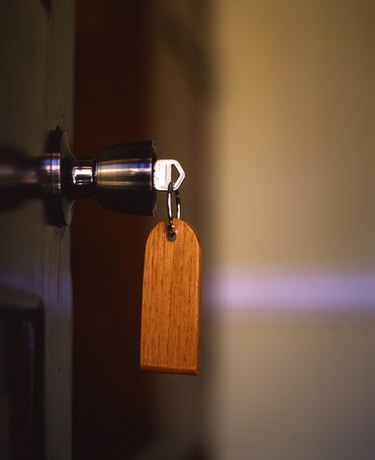Things You'll Need
Replacement pins
Follower bar
Vice
Schlage spanner (if necessary)

If you have one of the common pin-tumbler locks in a doorknob in your home, there is a good chance it is made by Schlage, one of the world's most popular lock companies. Should the lock become damaged and inoperable, it may be a problem with the internal pins that are manipulated by turning the key. A Schlage lock or any other brand of pin-tumbler lock can be disassembled so damaged pins can be replaced.
Step 1
Detach the knob from the door by inserting a key into the lock cylinder and turning it left without retracting the bolt. Then, depending on the type of doorknob, insert a Schlage spanner through the hole on the side of the knob shaft or use a small screwdriver to trigger the catch on the side of the knob shaft.
Video of the Day
Step 2
Remove the lock cylinder through the back of the knob. This may require pushing slightly on the inserted key to disengage the cylinder sleeve.
Step 3
Push the cylinder body off of the cylinder plug which contains the springs and pins. Place the follower bar, a small round piece of plastic roughly the same diameter as the cylinder plug, against the back of the cylinder plug, rotate the plug slightly and slide the cylinder body onto the bar. This prevents the top pins contained in the cylinder body from dropping out. Make sure you move the cylinder body and not the plug to prevent the bottom pins in the plug from "springing" out.
Step 4
Turn over the cylinder plug carefully, releasing the pins. Note which pins come from which holes in the cylinder. Swap out any damaged pins with replacements of the same length. Remove the key from the lock.
Step 5
Insert the cylinder plug into a vice, then use tweezers to reinsert the undamaged bottom pins as well as any replacement bottom pins. Be careful that the pins are inserted into the proper holes.
Step 6
Reinsert the key into the lock and ensure the bottom pins are now flush with the shear line at the top of the holes.
Step 7
Insert the cylinder plug back into the cylinder body from the front, gently pushing the follower bar out the back of the body. You should insert the cylinder plug at a slight angle to prevent bottom pins from improperly reengaging with the top pins and jamming the cylinder. Holding the plug and body together, turn the key to ensure the lock is functional.
Step 8
Reinsert the cylinder into the knob (after removing the key), then reattach the knob to the door using either the Schlage spanner or screwdriver to manipulate the catch, as appropriate.
Tip
If possible, use pins sold as part of a Schlage-specific pinning kit. That ensures they are the exact lengths necessary to match those contained in the lock. Otherwise, you may have to file the pins to ensure a perfect match.
Warning
Exercise extreme care in the handling of disassembled locks; one mistake can render the entire lock inoperable or force you into several extra steps, such as replacing the top pins if they slip out of the cylinder body.
Video of the Day